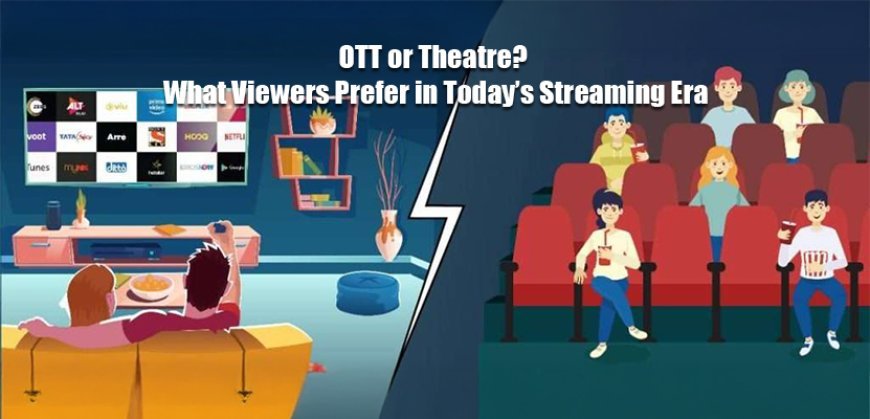OTT or Theatre? What Viewers Prefer in Today’s Streaming Era
OTT or theatres, where are movie lovers really heading? The answer might just surprise you in this new age of entertainment

OTT Streaming vs Theatrical Experience
The way we watch films has changed forever. It’s no longer a question of big screens or small screens; it’s about how we want to feel when we hit play. On one side, we’ve got the slick, on-demand world of OTT. On the other, the timeless thrill of theatre magic. Let’s break down the tug of war between these two titans of entertainment.
Unstoppable Rise of OTT Platforms
What started as a convenience is now a daily habit. OTT platforms like Netflix, Prime Video, and regional players in India are feeding over 547 million Indians, with nearly 38% tuning in daily. Whether you crave Korean thrillers, indie dramas, or Telugu originals, there’s always something waiting on your phone, on your time.
Globally, the OTT market hit a massive $316 billion in 2024, set to cross $429 billion by 2029. In India alone, it’s a $4 billion market this year, expected to grow by nearly 50% in five years.
And it’s not just about subscriptions anymore. Free streaming with ads (AVOD) is booming, already worth $3 billion in India. OTT players are also bagging exclusive rights for top movies, some fetching hundreds of crores, making theatres sweat.
How Theatres Are Adapting After COVID
Cinemas took a hard hit after COVID. In the U.S., attendance in early 2024 was still 33% lower than 2019. In India, moviegoers trickled back slowly, and the charm of the silver screen hasn’t been enough to pull in the pre-pandemic crowds.

But the story’s far from over. Theatres are rethinking the game with cocktail lounges, immersive experiences, 4DX effects, themed movie nights, and yes, even phone-friendly screenings. IMAX shows are selling out again. Some titles like Chhaava still smashed it, crossing Rs 600 crore at the box office.
And while advertising revenue is climbing again, projected to grow at 9% in 2025, the focus is shifting from filling seats to creating experiences.
How OTT and Theatres Differ
The clash between OTT and theatres boils down to personal preference and lifestyle. OTT platforms offer unmatched ease; you can watch from bed, on your phone, anytime you want. Theatres, on the other hand, require effort: driving out, waiting in lines, and sitting through scheduled showtimes. When it comes to cost, OTT wins hands down, with monthly subscriptions starting at Rs 149 for unlimited content. A single trip to the theatre, including tickets and snacks, can easily touch Rs 500 or more.
The feel of the experience is also vastly different. OTT viewing is personal and binge-worthy, perfect for solo time or casual watching. Theatres deliver a collective, immersive experience where the screen, sound, and crowd reactions amplify every moment. In terms of content, OTT thrives on experimental, regional, and indie stories, while theatres still lean toward grand, blockbuster-style productions designed for mass appeal.
OTT gives you freedom: pause, skip, rewind, snack whenever. Theatres offer flow, an uninterrupted, focused engagement. Even in creativity, OTT often pushes out fast-tracked, diverse stories across genres, while theatres take time to build grand, detailed narratives meant to impress on the big screen.
OTT Growth and Theatre Reinvention
The pandemic hit fast forward on OTT adoption, with over 1 billion OTT subscriptions globally in 2020. At the same time, theatres lost nearly 72% of their revenue that year.

But we’re seeing a balance emerge. Major films now follow a hybrid model that includes a theatrical run, followed by a streaming release after 30 to 45 days. This gives films a shot at both box office collections and streaming traction.
Theatres are no longer just movie halls. They’re evolving into “experience zones” with live music, special screenings, and family days. This reinvention is helping retain loyal patrons.
What’s Changing in the Way We Watch Films
Coexistence, not conflict: OTT will thrive on convenience and content depth. Theatres will shine with visual grandeur. One doesn’t kill the other.
Smart releases: Filmmakers now plan content around the platform. High-concept stories go to OTT, while big-screen spectacles are made for theatres.
More regional, more personal: OTT is doubling down on regional and local content, making sure everyone finds something close to home.
Tech-led theatre survival: Expect smarter ticket pricing, loyalty programs, and hyper local targeting from theatre chains to stay competitive.
Conclusion
You don’t have to choose sides. Watch a gripping crime series on your tablet during the week, and catch a big-screen epic on Saturday night with friends. OTT offers variety, ease, and intimacy. Theatres bring scale, community, and magic. Each has its own charm, and together, they make the future of film richer than ever.
FAQs
Why are so many people switching to OTT platforms?
Many switch to OTT for its convenience and lower cost. Watch anything, anytime, without leaving home or spending on theatre tickets.
Are theatres still worth visiting?
Yes, for big-screen films, theatres offer unmatched sound, visuals, and shared excitement you can’t get at home.
Can OTT platforms replace cinemas completely?
No, they serve different roles. OTT offers comfort and variety, while theatres deliver spectacle and shared moments. Both can coexist.
Do theatres make more money than OTT platforms?
It depends. Theatres profit from blockbusters, while OTT earns steadily through subscriptions and ads. They follow different models.
What kind of movies are better to watch in theatres?
Big action films, fantasy, and visually rich movies are best experienced in theatres.

 Admin
Admin